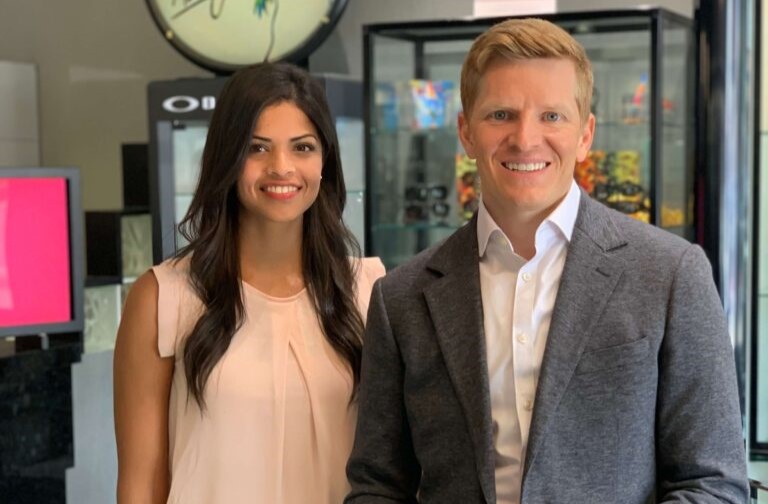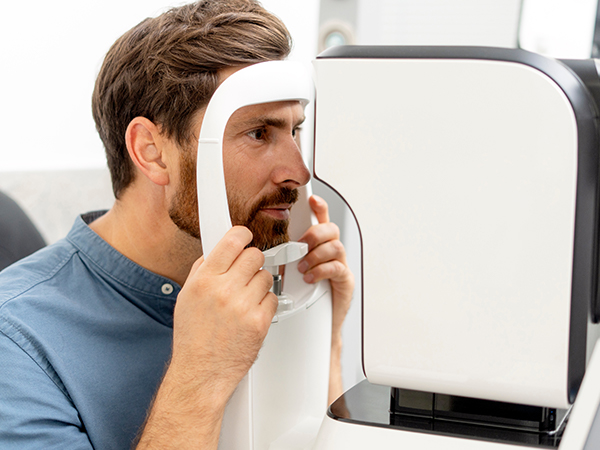Identifying crossed eye and lazy eye symptoms in eye exams
During comprehensive eye exams at our office in Carlsbad, California, our doctors check for many vision problems, including symptoms of strabismus and amblyopia. Our eye care staff will test visual acuity, eye refraction, visual alignment, and focus, examining overall eye health to assess if these conditions may be present.
What is strabismus?
Strabismus, more commonly known as crossed eye, is a vision condition in which the eyes do not align in the same direction. They appear to look different ways and do not focus on the same object. While the term “crossed-eye” is often used to refer to the condition, strabismus may involve an eye turning inward or outward. In addition, patients may experience eyes that do not move together, inadequate depth perception, double vision, frequent blinking and squinting, and more. Crossed eye (strabismus) is caused by a failure of the six muscles surrounding each eye to work together. As a result of this discoordination, the eyes focus on different objects and send different images to the brain. While older children and adults can develop the condition, crossed eye is most commonly diagnosed in infants and young children by the age of 3.

Eye care treatment for crossed eyes
Treatment for crossed eye (strabismus) can vary greatly depending on the severity and progression of the individual patient’s case. In some cases, eyeglasses or contacts may do the trick. Eyeglasses with special prism lenses may be necessary for some to reduce how much the eye must turn to view objects. In some severe cases, eye muscle surgery may be necessary.
Vision therapy is another typical treatment in which a series of visual activities are prescribed to encourage the brain and eyes to work together more effectively. This treatment also helps to promote better eye coordination and focus. Dr. Raja specializes in this therapy and is ready to help strabismus patients achieve effortless vision with top-tier eye care.
What is amblyopia?
Amblyopia is a vision condition in which one eye grows weaker than the other, typically during childhood. This weaker eye develops poor sight and may continue to worsen if left untreated. Amblyopia patients may experience misalignment of the eyes, poor depth perception, persistent head tilt, shaking of the eyes, squinting or shutting one eye in particular, and more. Amblyopia is also most common in infants and young children, so our vision care staff tests for amblyopia during pediatric eye exams.

Eye care treatment for lazy eye
Treatment for amblyopia typically involves forcing the brain to rely more heavily on the weaker eye, therefore strengthening the connection and improving sight. This is often done by temporarily weakening or blocking the image the brain receives from the stronger eye so the weaker eye must compensate.
Eye patching was a treatment commonly used to inhibit the stronger eye, but new research shows that this technique is not sufficient to promote proper eye teaming. Here at BVC, we are always looking for the best and most effective methods of treatment for achieving effortless vision. Our treatment methods for strabismus focus on strengthening eye teaming, or the eyes’ ability to properly work together. We will assess which treatment method is best for each individual patient, but we now consider eye patching to be obsolete.
How crossed eye and lazy eye are related
Crossed eyes (strabismus) causes the brain to receive a different image from each eye. Over time, the brain may learn to suppress the signals from the weaker eye. If the condition continues untreated, this can lead to lazy eye (amblyopia), and the eye may never work correctly. In some cases, lazy eye (amblyopia) can lead to crossed eye (strabismus) as well, though this is less common. At our office, we make sure to screen for these conditions, especially young children, to ensure the accuracy and longevity of visual health.

Keeping your eyes and vision healthy
While certain factors make crossed eye (strabismus) and lazy eye (amblyopia) more likely to occur, these conditions are almost impossible to prevent. Most common in children, crossed eye (strabismus) often has no known cause, though it tends to run in families. It can develop when the eyes have to compensate for other visual disorders, like farsightedness or cataracts. In adults, the condition is less likely to occur and usually stems from another issue, like a stroke, loss of vision, eye or blood vessel damage, etc.
Because crossed eye (strabismus) can lead to lazy eye (amblyopia) and a potential loss of vision, is it important to know how to detect the signs in yourself or your child so we can be proactive with treatment. If you notice: weakness in or around your eyes, a pulling feeling around your eyes, you need to turn or tilt your head to view objects, or changes in your sight, like blurry or double vision, schedule an appointment so we can ensure your eye health. If your child has eyes that look in different directions or don’t move together, or often has to tilt their head to view objects, schedule a pediatric eye exam for them. The earlier we can fit them for eyeglasses or begin treatment, the better!
More about our Carlsbad, California eye care services and exams
When it comes to the health of your vision, it is always better to be proactive! If you think that you or your child may be experiencing strabismus or amblyopia, schedule an appointment and feel free to call our office with questions. Our doctors’ advanced specialties allow us to offer a multitude of eye care services and treatments so that we can help our BVC family achieve effortless vision
Contact Us
Strabismus and amblyopia care FAQ
Strabismus has been diagnosed in about 4% of the United States, most often in infants and young children. Amblyopia begins in childhood and up to 3% of children have it. It is the most common cause of vision loss in children, so do not hesitate to bring your child in for a pediatric exam if you ever have concerns.
The American Optometric Association recommends that infants have their first eye exam at 6 months old. It is always better to be proactive, so bring your child in for more frequent eye exams if they display any concerns or changes in vision, or if there is a family history of vision problems.
Make sure to schedule regular eye exams for you and your child and be sure to be seen by a professional if you notice any irregularities! Crossed eye and lazy eye are most easily treated in their early stages, so it is always important to acknowledge concerns and come in for a visit annually.
Yes, vision therapy can be effective for adults, especially for issues like eye strain, binocular vision problems, or conditions such as convergence insufficiency. While children tend to respond quicker, adults can still see significant improvements in visual skills and comfort with the right therapy. Read more about the benefits of vision therapy for adults here.






